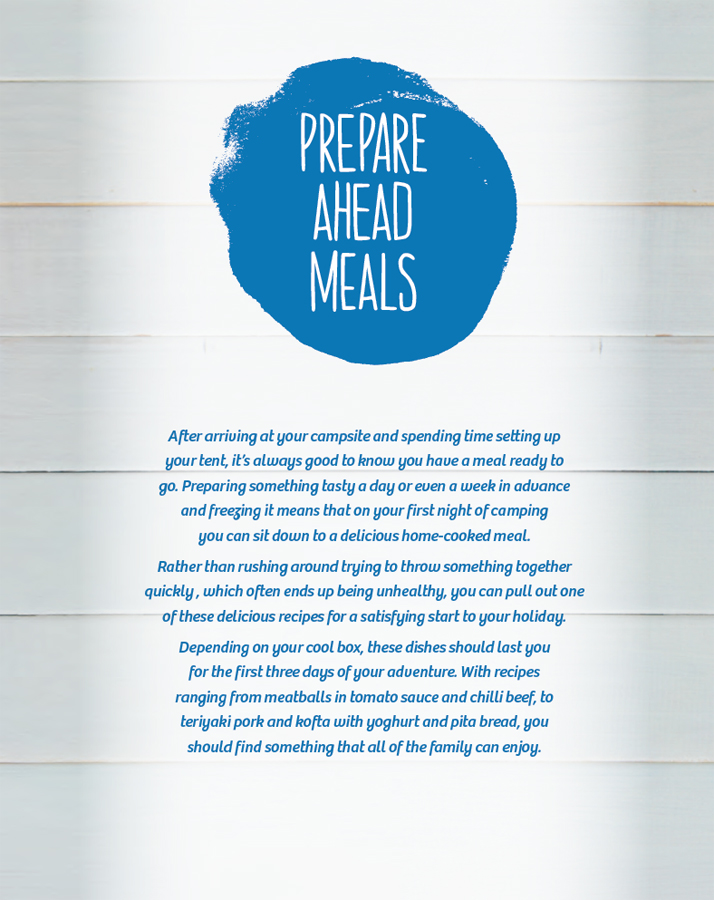

SPAGHETTI BOLOGNAISE CHOCK-FULL OF VEGIES
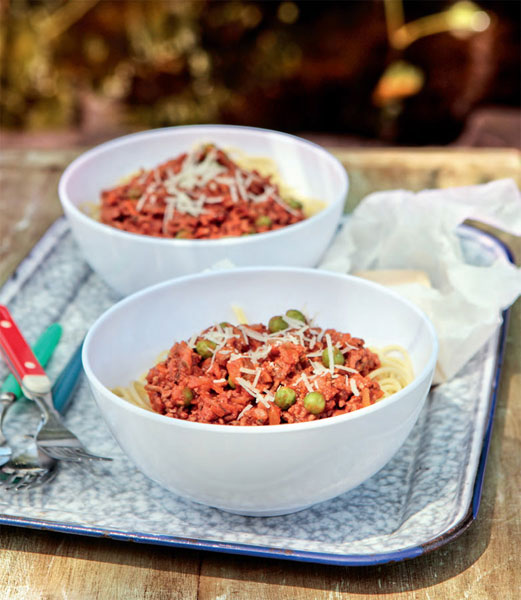
This is probably our family’s number one camping recipe. A few days before each trip, I always cook up a large batch. I freeze enough for the first night of our trip, but I often make extra for when we return home again, so once the car has been unpacked and the kids have been scrubbed down we don’t have to think about what to cook for dinner that night too!
SERVES 4–6
2 tablespoons vegetable oil or olive oil
600 g good-quality minced beef
1 onion, roughly chopped
3 garlic cloves, crushed
1 large carrot, peeled and grated or finely chopped
1 large zucchini (courgette), grated or finely chopped
150 ml red wine (optional)
700 g bottle tomato passata (purée)
2 large field mushrooms or 8–10 button mushrooms, finely chopped (optional)
140 g (1 cup) frozen peas
spaghetti or other pasta, to serve
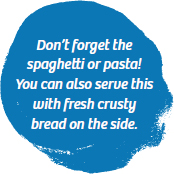
1 Heat 1 tablespoon of the oil in a large heavy-based saucepan over medium heat. Add the beef, in batches, and fry until brown. Remove and set aside.
2 Heat the remaining oil in the same pan over medium heat. Add the onion and garlic and fry for 5 minutes. Add the carrots and zucchini, and cook for about 5 minutes. Return the meat to the pan and add the wine. Bring to the boil and cook for 1 minute to boil off the alcohol.
3 Add the tomato passata, then add about 2 tablespoons water to the empty jar, swirl it around to get any leftover passata and pour into the pan. Add the mushrooms, if using, and season well with salt and freshly ground black pepper. Bring to the boil, then reduce the heat to low, cover, and simmer gently for 1–2 hours – the longer the better.
4 Stir in the peas, then leave to cool completely before transferring to airtight containers and freezing.

5 This dish can be cooked from frozen if necessary. Place in a camp oven or large saucepan and reheat over the fire or a gas cooker. Stir regularly as it cooks, ensuring it reaches boiling point before serving.

KOFTA WITH YOGHURT AND PITA BREAD
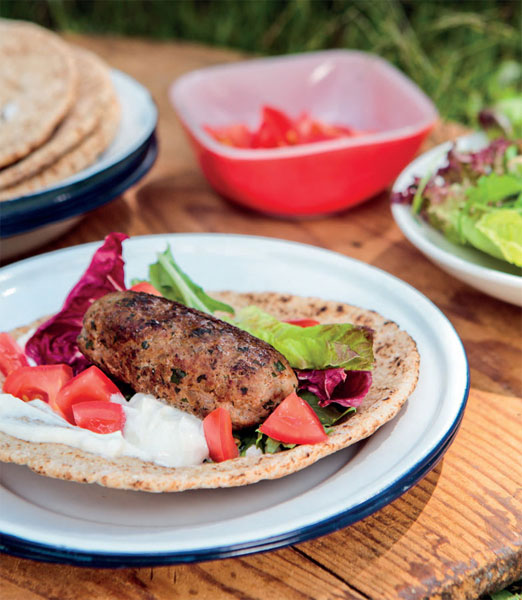
I often make these kofta for the adults when I’m making meatballs for the kids. However, kofta can be kid-friendly too, particularly if you leave out the harissa paste, although they aren’t that spicy even with harissa. They make a great addition to any gathering and are a cinch to cook on the barbecue.
SERVES 4 (MAKES 10 kofta)
1 teaspoon ground cumin
1 teaspoon ground coriander
2 tablespoons olive oil or vegetable oil, plus extra to serve
1 onion, finely chopped
3 garlic cloves, crushed
2 tablespoons finely chopped fresh coriander (cilantro) leaves
2 tablespoons finely chopped fresh mint leaves
1 teaspoon harissa (optional)
800 g good-quality minced lamb or beef
4–8 pita breads, to serve
3 tomatoes, chopped, to serve
green salad leaves, to serve
plain yoghurt, to serve

1 Heat a frying pan over medium–high heat. Add the cumin and coriander and dry-roast for about 1 minute, shaking the pan regularly. Transfer to a large mixing bowl.
2 Heat the oil in the frying pan and fry the onion for 5 minutes over low–medium heat, stirring regularly. Add the garlic and fry for 1 minute. Remove from the heat and transfer to the mixing bowl with the spices.
3 Put the remaining ingredients into the bowl and use your hands to mix well until combined. Divide the mixture into 10 even-sized portions and roll each portion into a fat sausage shape. Put into airtight containers and freeze.

4 Allow the kofta to defrost in your cool box, not in the sun. To cook the kofta, rub or brush them all over with oil to prevent them sticking to the pan. Place on a grill rack over the fire or on a hot barbecue flatplate and cook for 10–15 minutes, turning regularly, or until just cooked through. Put the pita bread close to the fire to warm through and toast slightly. Open the pita breads and serve the kofta inside, with chopped tomato, salad leaves and yoghurt.

CHILLI BEEF AND VEGETABLES
It’s up to you how spicy you make this dish. If you are serving it to kids or adults who don’t like chilli, then you can leave the chilli out altogether and make it more of a bean and beef stew. This dish is full of vegetables, so there is no need to serve it with any greens on the side, although you may like to partner it with some rice or crusty bread, a dollop of sour cream and a scattering of grated cheese.
SERVES 4–6
2 tablespoons olive oil
2 onions, finely chopped
2 garlic cloves, crushed
2 carrots, peeled and grated
2 zucchini (courgettes), finely grated
1 large red capsicum (pepper), seeded and diced
2–3 small red chillies, seeded and finely chopped
1 teaspoon ground cumin
1 teaspoon hot chilli powder
800 g good-quality minced beef
2 x 400 g tins kidney beans, rinsed and drained
2 x 400 g tins cherry tomatoes
250 ml (1 cup) tomato passata (purée)
1 teaspoon dried oregano
2 tablespoons chopped fresh coriander (cilantro)
1 Heat the oil in a large heavy-based saucepan or casserole dish (or in your camp oven if you are making it at the campsite). Add the onion, garlic, carrot, zucchini and capsicum and fry gently for about 10 minutes.
2 Add the fresh chilli, ground cumin and chilli powder and cook for 1 minute, stirring everything together.
3 Increase the heat to high and add the beef. Cook for 2–3 minutes, stirring until the beef is brown. Add the kidney beans, cherry tomatoes, tomato passata and oregano and season with salt and freshly ground black pepper. Bring to the boil, then reduce the heat to low, cover, and simmer for at least 1 hour. If you prefer your chilli slightly thicker, simmer with the lid off for a further 15 minutes. Stir in the coriander.
4 Remove from the heat and allow to cool. Transfer to airtight containers and freeze.

5 Allow the chilli beef and vegetables to defrost in the cool box (although it can also be cooked from frozen) then reheat in a saucepan over a fire or gas cooker. Ensure it is piping hot before serving.

YOGHURT AND SPICE-MARINATED CHICKEN
As well as tasting sensational, this yoghurt marinade acts as a tenderiser and helps stop the chicken from drying out as it cooks. If you’re making this while camping, don’t worry about dry-frying the spices beforehand, just add them straight to the marinade. Leave the meat to develop in the cool box for at least 1 hour before cooking. This marinade also works well with lamb cutlets or pork chops.
SERVES 4
650 g skinless, boneless free-range chicken thigh or breast fillets, cut into large pieces (if the breast meat is particularly thick, halve horizontally)
YOGHURT SPICE MARINADE
1 teaspoon ground cumin
1 teaspoon ground coriander
200 g plain yoghurt
2 tablespoons apricot chutney
1 To make the marinade, heat a small frying pan over medium heat. Add the cumin and coriander and dry-roast for about 30 seconds, shaking the pan regularly. Tip into a small bowl.
2 Add the yoghurt and chutney to the toasted spices, season with salt and freshly ground black pepper and mix well.
3 Put the chicken into an airtight container and add the yoghurt marinade. Mix everything together well and refrigerate for a few hours to allow the flavours to infuse. Transfer to the freezer and freeze for at least 12 hours.

4 Allow the chicken to defrost in your cool box, not in the sun. If cooking directly over the fire or on a barbecue the chicken will take around 10–15 minutes, turning regularly. Alternatively, you can thread the chicken onto metal skewers, then sit a couple of bricks or rocks on a grill rack over the fire, balancing the skewers between the bricks to prevent them burning. Cooking them this way will take a little longer. Ensure they are cooked through before serving.

TERIYAKI PORK
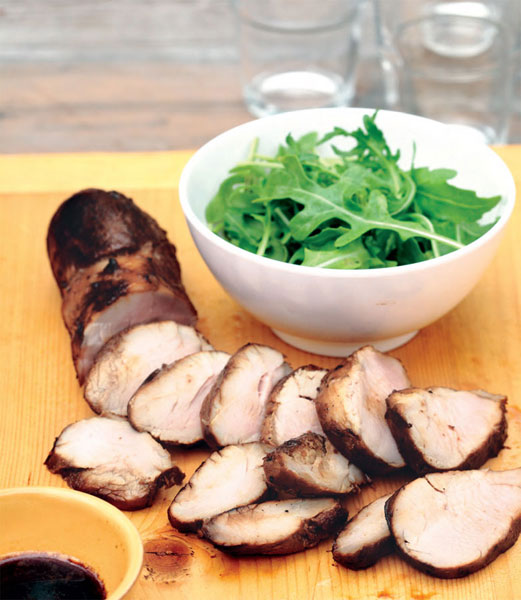
When I am camping, I often start thinking about what to cook for dinner early in the day. Having a delicious piece of pork loin already marinated means I only need to think about a salad to serve it with. Teriyaki pork is a favourite with my kids, who start milling around the fire as the tantalizing smells begin wafting through the campsite. This marinade will work just as well with chicken or beef.
SERVES 4
80 ml (⅓ cup) soy sauce
80 ml (⅓ cup) mirin
1 teaspoon roasted sesame oil
2 tablespoons honey
1 garlic clove, crushed (optional)
750 g (about 2) pork fillets
green salad and potato salad, to serve
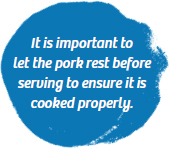
1 Combine the soy sauce, mirin and sesame oil in a large shallow dish. Add the honey and stir well. Add the garlic and season with pepper.
2 Cut several shallow slashes across both sides of the pork to allow the marinade to get into the meat. Put the meat into the dish and turn in the marinade a few times to coat. Marinate in the refrigerator for at least 2 hours.
3 Transfer the pork and marinade to a large re-sealable snack bag or airtight container and freeze for at least 12 hours.

4 Allow the pork to defrost in the cool box, not in the sun. Remove the pork from the marinade and if possible, pat dry with paper towel (this helps with getting a nice crisp outside).
5 Cook on a barbecue or grill rack over the fire for 3–4 minutes on each side. At this point, wrap it in foil to prevent the outside burning before the middle is cooked. Move to a cooler part of the barbecue or to the side of the fire and cook for a further 15–20 minutes. The cooking time will depend on the heat, but it is safe to serve the meat when it is still a little pink in the middle.
6 Once cooked, wrap the pork in foil (if not already wrapped) and let it sit for 10 minutes to finish cooking. Slice and serve with the salads.

MEATBALLS IN TOMATO SAUCE
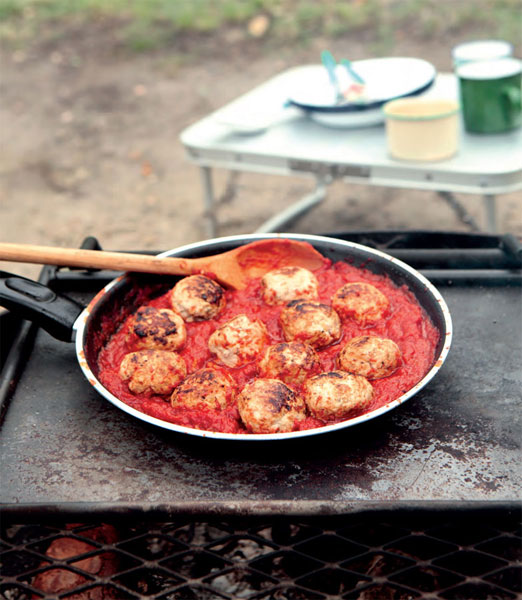
These meatballs have been loved by pretty much every kid and adult who have eaten them. Served with a basic tomato sauce, this recipe is the simplest version that I make, but you can enhance their flavour by adding some freshly chopped parsley or chives, a finely chopped chilli, some chopped black olives, grated zucchini (courgette) or carrot.
SERVES 4
(MAKES 20 meatballs)
80 ml (⅓ cup) milk
2 slices of wholemeal bread, crusts removed, cut into small pieces
1 tablespoon vegetable oil, plus extra
1 onion, finely chopped
1 large garlic clove, crushed
700 g good-quality minced pork or beef
700 g bottle tomato passata (purée)
spaghetti or other pasta, to serve
grated parmesan or cheddar cheese, to serve
1 Put the milk in a small bowl, add the bread and mix to combine. Leave the bread to soak up the milk.
2 Meanwhile, heat the oil in a frying pan over low–medium heat. Add the onion and garlic and cook for 3–4 minutes, or until softened but not browned. Transfer to a mixing bowl and add the mince.
3 Squeeze the milk from the bread and crumble into the mince; discard the milk. Season with salt and freshly cracked black pepper, then use your hands to mix everything together.
4 Take about 1 heaped tablespoon of the mixture at a time and roll into small balls – you should make about 20 meatballs. Arrange in layers in an airtight container, separated by baking paper, and freeze.

5 Allow the meatballs to defrost in the cool box, not in the sun. Heat a little oil in a large frying pan or camp oven. Fry the meatballs for 5–8 minutes, turning regularly. Pour in the tomato passata, stir gently, then reduce the heat, cover, and simmer for 10 minutes. If the sauce gets too dry, add a little water.
6 Meanwhile, cook the spaghetti according to the packet instructions and serve the meatballs on top with some grated cheese.

PORK AND VEAL MINCE WITH ROOT VEGETABLES
Parsnips add a little sweetness to this dish. If you prefer, minced beef could easily be used instead of pork and veal. My family really enjoy eating this hearty meal, especially when we’re camping in the mountains on chilly winter evenings.
SERVES 4–6
2 tablespoons olive oil
600 g good-quality mixed minced pork and veal
1 large onion, chopped
2 garlic cloves, crushed
2 carrots, peeled and grated
2 parsnips, peeled and grated
1 teaspoon dried oregano or parsley
700 g bottle tomato passata (purée)
spaghetti or other pasta, to serve
grated cheese, to serve
1 Heat 1 tablespoon of the oil in a large casserole dish or heavybased saucepan over medium heat. Add the pork and veal minces in two batches and cook, stirring occasionally, for 3–4 minutes until browned. Transfer to a bowl.
2 Heat the remaining tablespoon of oil in the same pan over medium heat. Add the onion and garlic and cook gently for about 5 minutes. Add the carrots and parsnips and cook for a further 5 minutes.
3 Return the meat to the pan and stir in the oregano and passata. Add 185 ml (¾ cup) water to the passata bottle, swirl it around, then add to the pan, stirring to combine. Season well with salt and freshly ground black pepper.
4 Bring to the boil, then reduce the heat to low, cover, and simmer for 1 hour. Remove from the heat and cool completely before transferring to airtight containers and freezing.

5 This dish can be cooked from frozen. Place in a camp oven or heavy-based saucepan and sit to one side of the fire or over a low gas cooker and stir regularly. Ensure it reaches boiling point before serving. Serve with cooked spaghetti and grated cheese.

CAJUN FISH FILLETS
Pretty much any white fish fillet can be used for this dish, although it’s best to avoid very thin fillets as they don’t defrost very well. You can also make this at the campsite if you have a fisher-person in your party – just don’t forget to bring the store cupboard ingredients with you.
SERVES 4
1 tablespoon Cajun spice mix
2 teaspoons ground paprika
1 tablespoon lemon juice
2 tablespoons olive oil
2 garlic cloves, crushed
1 teaspoon freshly ground black pepper
700–800 g firm white fish fillets, such as cod, flathead or snapper
lemon wedges, to serve
green salad, to serve
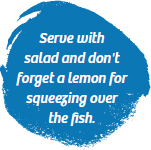
1 In a bowl, combine the Cajun spice mix, paprika, lemon juice, olive oil, garlic and black pepper. Rub all over the fish fillets, gently massaging the marinade into the flesh.
2 Place in the refrigerator for a couple of hours to allow the flavours to penetrate into the fish. Transfer to a re-sealable snack bag or airtight container and freeze for at least 24 hours.

3 Allow the fish to defrost in the cool box, not in the sun. Cook on a barbecue flatplate or over a fire for about 4 minutes on each side. This is the timing for fish that is about 2 cm thick; if your fish is any thicker it will take longer. Do not overcook the fish or it will become dry. Serve with lemon wedges and a simple green salad on the side.

MARINATED FISH FILLETS
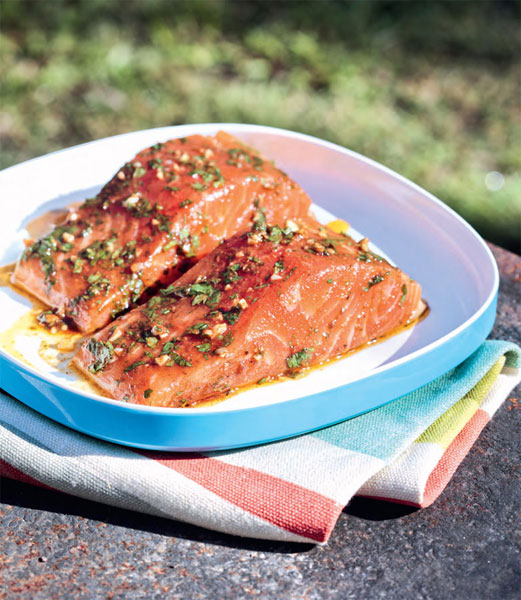
This tasty marinade relies on fresh coriander and a mixture of tasty spices for its unique flavour – you can make it in advance or at the campsite. If you’ve got a fire going, wrap some potatoes in foil and bake for 45–60 minutes in the hot coals to serve alongside the fish for a memorable fireside dinner.
SERVES 4
1 teaspoon ground coriander
1 teaspoon ground cumin
1 teaspoon ground ginger
2 tablespoons olive oil
2 garlic cloves, crushed
1 teaspoon harissa paste
2 tablespoons chopped fresh coriander (cilantro) leaves
4 x 180–200 g salmon, cod, snapper or other firm fish fillets
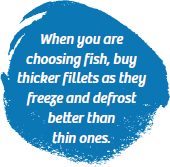
1 Heat a small frying pan over medium heat. Add the ground coriander, cumin and ginger and dry-roast for about 1 minute, shaking the pan regularly. Transfer to a small bowl.
2 Add the oil, garlic, harissa and coriander leaves to the bowl with the spices, season with salt and freshly ground black pepper, and mix well.
3 Place the fish fillets into a re-sealable snack bag and add the marinade. Massage the fish gently to coat. Place in the refrigerator for a couple of hours to allow the flavours to penetrate. Freeze for at least 24 hours.

4 Defrost the fish in your cool box, not in the sun. Cook the fish on a barbecue or on a grill rack over the fire for about 5 minutes on each side, or cook in a pan on a gas cooker. Cooking times will depend on the thickness of your fish. If the fire is very hot, sit the fish at the edge, otherwise the outside will burn before the inside is cooked. Do not overcook the fish, or it will be dry.

VEGETABLE AND CHICKPEA CASSEROLE
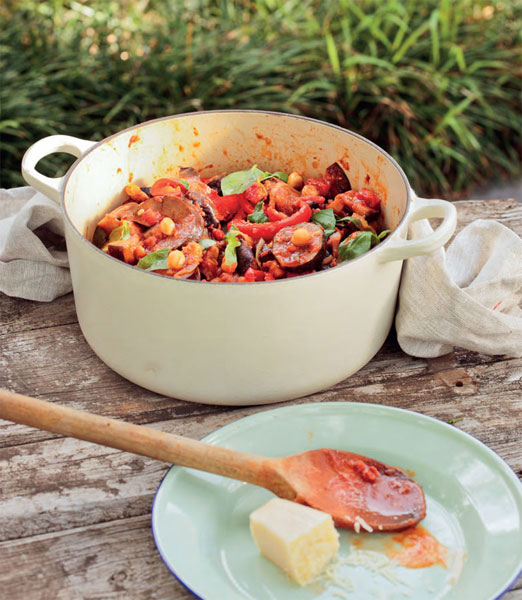
This dish is reminiscent of a French-style ratatouille, but with extra vegetables and chickpeas. It can be served as a main meal with couscous or as an accompaniment to grilled meat and fish. Alternatively, for a quick meal, serve cold with slices of crusty bread.
SERVES 4
(or 8 as an accompaniment)
60 ml (¼ cup) olive oil
1 large onion, halved and thinly sliced
1 red capsicum (pepper), seeded and cut into thin strips
2 garlic cloves, crushed
2 eggplant (aubergines), halved lengthwise and cut into 1 cm slices
2 zucchini (courgettes), cut into 1 cm slices
400 g tin diced tomatoes
400 g tin chickpeas, rinsed and drained
½ teaspoon ground coriander
1 small handful fresh basil leaves, roughly torn
grated parmesan cheese, to serve
1 Heat 2 tablespoons of the oil in a large heavy-based casserole dish or saucepan over medium heat. Add the onion and cook for about 5 minutes, or until soft.
2 Add the capsicum, garlic, eggplant, zucchini and remaining oil. Stir well, cover, and cook over low heat for 25–30 minutes, stirring occasionally. The heat needs to be not so low that nothing happens, but not too hot that it dries out.
3 Add the tomatoes, chickpeas and coriander. Season with salt and freshly ground black pepper, cover again, and simmer for a further 20 minutes, or until the vegetables are soft but not mushy.
4 Stir in the basil and leave to cool completely. Transfer to an airtight container and freeze for at least 12 hours.

5 This dish can be cooked from frozen or partially frozen. Place in a camp oven or heavy-based saucepan and sit to one side of the fire so it doesn’t get too hot. As it heats you need to stir it regularly. Alternatively, you can cook it in a saucepan over a gas cooker. Ensure it reaches boiling point before serving. Serve with parmesan cheese scattered over the top, if desired.